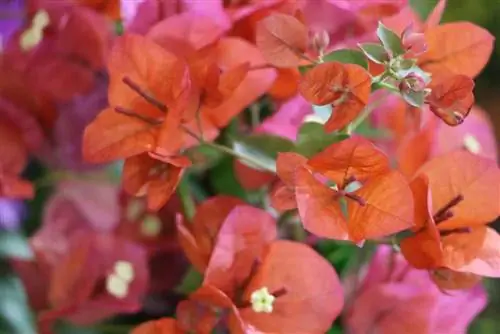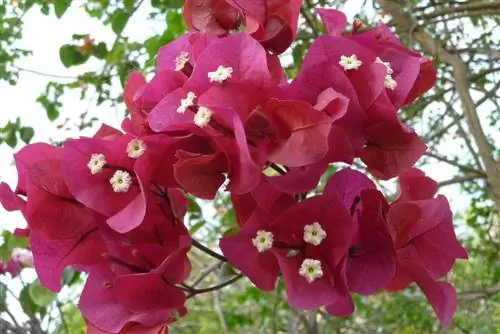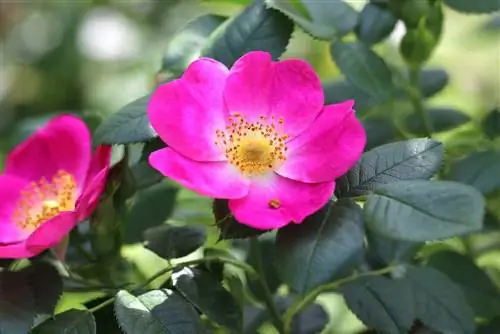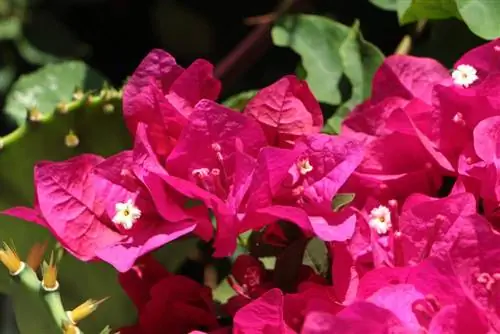- Author admin [email protected].
- Public 2023-12-17 03:39.
- Last modified 2025-01-24 12:45.
The bougainvillea, also known as the triplet or bird flower, is relatively fast-growing and is mainly cultivated in this country as a shrub or trunk, and more rarely as a climbing plant. With its 10-18 species, it is not one of the most species-rich but certainly one of the most magnificent plants. The special thing about the triplet flower is not the small white flowers, but the colored bracts that surround the flower and, in contrast to the actual flowering, which only lasts a few days, appear in the most magnificent colors for several weeks, provided they are cut regularly.
Time to cut
Pruning in spring
The bougainvillea is a very cut-tolerant plant that can tolerate almost any cut. Pruning measures can be carried out at different times, with early spring between the beginning of February and the end of March being the best time for heavy pruning. This should be done at the start of budding or before the plant develops new buds. Such a radical cut in spring is intended to promote the formation of many new shoots, but at the same time serves to maintain the he alth of the plants.
Summer cut
In addition to radical pruning in spring, appropriate pruning measures are possible during complete growth, even in summer. However, these cuts should not be as severe as the spring cut, but should be done after each new burst of flowers, approximately every four weeks. The main thing is to cut the bougainvillea into shape, trim it and clean it out.
Autumn cut
If the plants have grown too sprawling, perhaps because the pruning was neglected in spring or the space available for overwintering is rather limited, the triplet flower can also be pruned before moving to winter quarters, i.e. in autumn. This cut can easily be made a little thicker again.
Tip:
The later you prune harder, the later this plant will develop flowers.
Spring pruning instructions
The bougainvillea, like most summer bloomers, blooms on new growth or this year's shoot. Therefore, as already mentioned, the main cut should be done in early spring at the start of budding. However, care must be taken not to cut too early, otherwise severe frost damage can occur to the young shoots. On the other hand, if you wait too long to cut, for example until buds have already formed, you remove the new shoots and thus minimize the number of flowers.
- When pruning in spring, radically remove all flowers or side shoots that extend from the main shoot.
- Cut shoots directly at the base.
- Otherwise, completely remove diseased, dead and wilted parts of the plant up to the main tendril.
- Remove disturbing shoots completely.
- When growing as a shrub or trunk, trim the plants all around.
- This can or should be done several times throughout the season.
- We always cut back until an attractive spherical shape is achieved.
- Cut back up to two thirds.
- This brings the triplet flower into shape and makes it grow denser or bushier.
- Depending on the degree of woodiness, cut back subshrubs to about half or a third.
Tip:
Before each cut, it is advisable to disinfect the respective cutting tools with alcohol to avoid the transmission of diseases. It is also advisable to wear thick gloves, because the triplet flower has relatively thick and sharp thorns that can easily injure yourself.
Instructions for summer cutting
As already mentioned, it can be trimmed several times throughout the entire growing period. In contrast to spring pruning, no entire branches or shoots are removed, but only shaping cuts are made. Long shoots that formed from spring to summer can now be shortened. This also applies when flower production slows down.
Ideally, the new shoots, which can be recognized by their light green bark, are shortened by about half. Blending is carried out as soon as the first blossom has withered or dried out. Withered bracts can be recognized by their parchment-like structure. This cut promotes better branching on the shoot stubs or the formation of numerous short shoots and, after about a month, the formation of new flowers or bracts. To ensure recurring flowers, summer pruning on free-standing specimens should be repeated approximately every four weeks, i.e. H. after each subsequent flush of flowers. This four-week cut is also recommended for spherical triplet flowers and should be done on young plants. The more regularly the bougainvillea is cut, the more compact its growth will be and the more it will bloom. After cutting, it is recommended to fertilize the plants in question, because every cut means stress for the plants.
Tip:
If you don't cut at all during the growth phase, the plants will develop very long, thorny shoots. Since bougainvillea only blooms at the tips of the shoots, this significantly reduces flower formation. That's why regular pruning immediately after flowering makes sense.
Instructions for autumn pruning

If the bougainvillea was able to grow unhindered or if the space in the winter quarters is limited, instead of a spring cut, a more severe cut can be carried out in the fall before overwintering. However, if all the necessary pruning measures have been carried out regularly both in spring and during the growth and flowering phase, autumn pruning can be completely dispensed with.
More care tips for bougainvillea
The triplet flower is relatively fast-growing and can develop meter-long tendrils. If it is cultivated as a climbing plant, it needs a stable trellis. Depending on the variety, the intensely colored white, yellow, orange or pink, red or blue bracts appear in several bursts of flowers. The more sunlight the plant receives, the stronger the color intensity. Therefore, full sun to sunny locations are optimal. In summer, bougainvillea needs plenty of water, especially when new flower buds appear. It cannot tolerate waterlogging, which can quickly lead to root rot.
Bougainvillea is not frost-hardy in this country and is therefore almost exclusively cultivated as a container plant. It should overwinter cool to cold but frost-free. Temperatures must not fall below 0 °C. Most species shed their leaves in winter, so they can be moved to a darker place if necessary. At overwintering temperatures of 12 °C (+/- 5 K), for example in a winter garden, some species also bloom in winter.
From February it should be made brighter and warmer again, watered more and fertilized for the first time when budding begins. The triplet flower can only go outside when night frosts are no longer expected or, better, after the so-called sheep's cold, between 4.and June 20th, because during this time there can be another cold snap, although this does not happen every year. If necessary, it can be repotted in fresh soil in the spring. However, you shouldn't repot too often, because the bougainvillea prefers it to be a little more cramped in the root area. For this reason, the new planter should only be slightly larger. If it is too big, the plant invests a lot of energy in root formation and size growth, which in turn affects flower production.
Conclusion
The perennial bougainvillea is one of the most beautiful potted plants ever, provided it is trimmed regularly. Then from spring to autumn it shows its striking, colorful bracts several times. Ideally, it should be pruned back heavily in spring and then trimmed or shortened again about every four weeks as soon as the bracts have wilted. If you let this plant grow undisturbed, it will produce very long, thin shoots. Tendrils that over time produce fewer or no flowers at all.
What you need to know about bougainvillea care
Bougainvilleas bloom mainly at the ends of the shoots. If you cut the climbing plant back annually, it develops into a compact, well-branched bush that flowers intensively. In addition to normal pruning, you also shorten the shoots after each burst of flowers.
Care
- Location must be sunny - the plants like as much sun as possible.
- A warm, airy place protected from the rain is ideal. The plants don't like drafts or a lot of wind.
- The plant substrate should be nutrient-rich, permeable, but also somewhat moisture-retaining.
- Enrich standard standard soil with a little clay, that's enough.
- Watering only a little. The plant substrate should not dry out! Short dry periods in summer stimulate flower formation.
- Fertilize a lot! During the growing season every one to two weeks with normal liquid fertilizer as directed.
Wintering
- The best way to overwinter a bougainvillea is in a cold house. The plant is not hardy.
- The following applies: overwinter cool to cold, always keep frost-free. In cold and dark conditions the plant sheds its leaves.
- During the dormant period you should water rarely, but don't let it dry out completely! Fertilization should also be avoided.
- In spring you should place the plant in a bright and warm place in good time (February). A south window is ideal.
- Fertilization can start again as soon as the first leaves have sprouted.
- From this point on, water more, but still sparingly so that not only leaves form.
- When clearing out after the Ice Saints, you should first put the plant in the shade and slowly get used to the sun!
- Overwintering is also possible in the winter garden at around 15 °C. Then the bougainvillea usually blooms through.
- Repotting rarely! Bougainvilleas bloom better in cramped containers.
Cutting
- A radical cut is best done in spring when budding begins in early February to March.
- The later you cut, the later the bougainvillea will bloom.
- Cut back all side shoots from the main shoots completely directly at the base. This brings lots of strong new flower shoots.
Bougainvillea can be grown as a standard tree or even a tree, a bushy shrub or in any other form. You can trim the plant easily:
- In summer, only the long shoots are shortened when the flowering on them slows down. This is how richly flowering short shoots are formed.
- If necessary, the bougainvillea can be cut before it is put away in the fall. Then it doesn't need as much space in its winter quarters.






